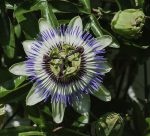 Also known as bluecrown passionflower and common passion flower, this vigorous vine is native to South America from Bolivia to Brazil and northern Argentina. It is a member of the Passifloraceae, a family of 750 species of mostly tropical trees, shrubs and vines and is evergreen in the tropics but deciduous in colder areas. The plants grow quickly to 10-40′ and has green to brown hairless stems with coiled green tendrils 2-4″ long at the base of the leaves. The shiny, hairless, green leaves are 3-6″ long and are palmately lobed usually with 5 lobes but 3,7, or 9 lobes are possible. From early summer to early fall, solitary saucer-shaped flowers appear on long stalks. Each flower is up to 4″ wide and has 10 rounded tepals ( petals and sepals) that are bluish white and surround a corona of blue, white and brown filaments. Three purple styles and 5 greenish-yellow stamens occupy the center of the flower. The fruit is a 1-3″ long berry that is at first green but matures to yellow or orange by fall. It is partially hollow inside and has a small amount of dark red pulp with a large number of seeds. Although the fruit is edible it is not tasty. Blue passionflower gives a tropical look to gardens and greenhouses but can be tricky to grow well because it is suceptible to numerous fungal diseases in high humidity and damage by butterfly larvae that devour its foliage. With its showy blooms it is a good choice for walls, fences, arbors, and containers and will not cause damage because it climbs by tendrils. Can become invasive. The genus name, Passiflora, comes from the Latin words passio meaing suffering, and flos meaning flower and refers to the suffering of Christ because the flower is symbolically associated with the crucifixion. The specific epithet, caeruleae, is the Latin word meaning dark blue.
Also known as bluecrown passionflower and common passion flower, this vigorous vine is native to South America from Bolivia to Brazil and northern Argentina. It is a member of the Passifloraceae, a family of 750 species of mostly tropical trees, shrubs and vines and is evergreen in the tropics but deciduous in colder areas. The plants grow quickly to 10-40′ and has green to brown hairless stems with coiled green tendrils 2-4″ long at the base of the leaves. The shiny, hairless, green leaves are 3-6″ long and are palmately lobed usually with 5 lobes but 3,7, or 9 lobes are possible. From early summer to early fall, solitary saucer-shaped flowers appear on long stalks. Each flower is up to 4″ wide and has 10 rounded tepals ( petals and sepals) that are bluish white and surround a corona of blue, white and brown filaments. Three purple styles and 5 greenish-yellow stamens occupy the center of the flower. The fruit is a 1-3″ long berry that is at first green but matures to yellow or orange by fall. It is partially hollow inside and has a small amount of dark red pulp with a large number of seeds. Although the fruit is edible it is not tasty. Blue passionflower gives a tropical look to gardens and greenhouses but can be tricky to grow well because it is suceptible to numerous fungal diseases in high humidity and damage by butterfly larvae that devour its foliage. With its showy blooms it is a good choice for walls, fences, arbors, and containers and will not cause damage because it climbs by tendrils. Can become invasive. The genus name, Passiflora, comes from the Latin words passio meaing suffering, and flos meaning flower and refers to the suffering of Christ because the flower is symbolically associated with the crucifixion. The specific epithet, caeruleae, is the Latin word meaning dark blue.
Type: Deciduous or semi-evergreen twining vine
Bloom: Large solitary bluish white flowers in summer
Size: 10-40′ H x 3-6′ W
Light:Full sun to partial shade
Soil: Average, medium moist, well-drained; water cautiously to encourage a deep root system’
Hardiness: Zones 7-9
Care: Maintain good circulation to control fungal diseases in humid conditions; water deeply but infrequently so as to encourage deep root growth; prune before new growth begins by removing some stems but always leave some greenery on the plant; pinch tips after flowering to encourage bushiness; fertilize sparingly so as not to encourage foliage at the expense of flowers.
Pests and Diseases: Many fungal diseases in high humidity; root root in overly moist soil
Propagation:Seed, stem cuttings in spring, layering in late summer
Companion Plants: Gerber daisy, mandevilla, zebra plant
Outstanding Selections:
‘Chinensis’ (corona filaments paler blue)
‘Constance Elliott’ (pure white, fragrant flowers; not as free-flowering as many other cultivars)
‘Pierre Pomie’ (pale pink flower)
Photo Credit: Franz van Duns Wikipedia